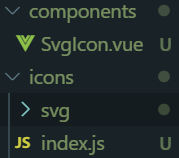Vue中引入svg圖標(biāo)的兩種方式
Vue中引入svg圖標(biāo)的方式
Vue中引入svg圖標(biāo)的方式一安裝
yarn add svg-sprite-loader --dev
svg組件

index.vue
<!-- svg組件 --><template> <svg : aria-hidden='true'> <use :xlink:href='http://www.gepszalag.com/bcjs/iconName' /> </svg></template><script>export default { name: ’SvgIcon’, props: { // svg 的名稱 svgName: { type: String, required: true } }, computed: { iconName () { return `#icon-${this.svgName}` }, svgClass () { if (this.svgName) { return ’svg-icon’ + this.svgName } else { return ’svg-icon’ } } }}</script><style lang='less' scoped>.svg-icon { width: 100px; height: 100px; vertical-align: -0.15em; fill: currentColor; overflow: hidden;}</style>
注冊到全局

index.js
import Vue from ’vue’import SvgIcon from ’@/components/SvgIcon’// 注冊到全局Vue.component(’svg-icon’, SvgIcon)const requireAll = requireContext => requireContext.keys().map(requireContext)const req = require.context(’./svg’, false, /.svg$/)requireAll(req)
vue.config.js
module.exports = {chainWebpack: config => { config.module .rule(’svg’) .exclude.add(resolve(’src/assets/icons’)) .end() config.module .rule(’icons’) .test(/.svg$/) .include.add(resolve(’src/assets/icons’)) .end() .use(’svg-sprite-loader’) .loader(’svg-sprite-loader’) .options({ symbolId: ’icon-[name]’ }) .end()} }
頁面中使用
<!-- svg-name為svg名 --><svg-icon svg-name='ic_home_news' />Vue中引入svg圖標(biāo)的方式二
npm install svg-sprite-loader --save-dev
vue.config.js中添加如下代碼
const path = require(’path’);function resolve(dir) { // __dirname項目根目錄的絕對路徑 return path.join(__dirname, dir);}module.exports = { chainWebpack: config => { const svgRule = config.module.rule(’svg’); // 清除已有的所有l(wèi)oader // 如果你不這樣做,接下來的loader會附加在該規(guī)則現(xiàn)有的loader之后 svgRule.uses.clear(); svgRule .test(/.svg$/) .include.add(path.resolve(__dirname, ’./src/icons/svg’)) .end() .use(’svg-sprite-loader’) .loader(’svg-sprite-loader’) .options({ symbolId: ’icon-[name]’ }); const fileRule = config.module.rule(’file’); fileRule.uses.clear(); fileRule .test(/.svg$/) .exclude.add(path.resolve(__dirname, ’./src/icons/svg’)) .end() .use(’file-loader’) .loader(’file-loader’); },}
建立如下的文件目錄

SvgIcon.vue代碼
<template> <svg : xmlns='http://www.w3.org/2000/svg'> <use :xlink:href='http://www.gepszalag.com/bcjs/iconName' xmlns:xlink='http://www.w3.org/1999/xlink' /> </svg></template><script>export default { name: ’SvgIcon’, props: { iconClass: { type: String, required: true }, className: { type: String, default: ’’ } }, computed: { iconName() { return `#icon-${this.iconClass}`; }, svgClass() { if (this.className) { return ’svg-icon ’ + this.className; } else { return ’svg-icon’; } } }};</script><style scoped>.svg-icon { width: 1em; height: 1em; vertical-align: -0.15em; fill: currentColor; overflow: hidden;}</style>
svg文件夾下放svg圖標(biāo)
index.js代碼
import Vue from ’vue’;import SvgIcon from ’@/components/SvgIcon’; // svg組件// register globallyVue.component(’svg-icon’, SvgIcon);const req = require.context(’./svg’, false, /.svg$/);const requireAll = requireContext => requireContext.keys().map(requireContext);requireAll(req);
最后在main.js中引入
import ’./icons’;
在頁面中使用svg
icon-class是svg圖標(biāo)名 class-name是你要自定義的class類名
<svg-icon icon- class-name='icon'></svg-icon>總結(jié)
到此這篇關(guān)于Vue中引入svg圖標(biāo)的兩種方式的文章就介紹到這了,更多相關(guān)Vue引入svg圖標(biāo)內(nèi)容請搜索好吧啦網(wǎng)以前的文章或繼續(xù)瀏覽下面的相關(guān)文章希望大家以后多多支持好吧啦網(wǎng)!
相關(guān)文章:
1. 低版本IE正常運行HTML5+CSS3網(wǎng)站的3種解決方案2. jsp實現(xiàn)局部刷新頁面、異步加載頁面的方法3. xml文件的結(jié)構(gòu)解讀第1/2頁4. Jsp中request的3個基礎(chǔ)實踐5. python GUI庫圖形界面開發(fā)之PyQt5工具欄控件QToolBar的詳細使用方法與實例6. 使用python修改文件并立即寫回到原始位置操作(inplace讀寫)7. python GUI庫圖形界面開發(fā)之PyQt5計數(shù)器控件QSpinBox詳細使用方法與實例8. Python填充任意顏色,不同算法時間差異分析說明9. Java map.getOrDefault()方法的用法詳解10. 什么是python的id函數(shù)

 網(wǎng)公網(wǎng)安備
網(wǎng)公網(wǎng)安備